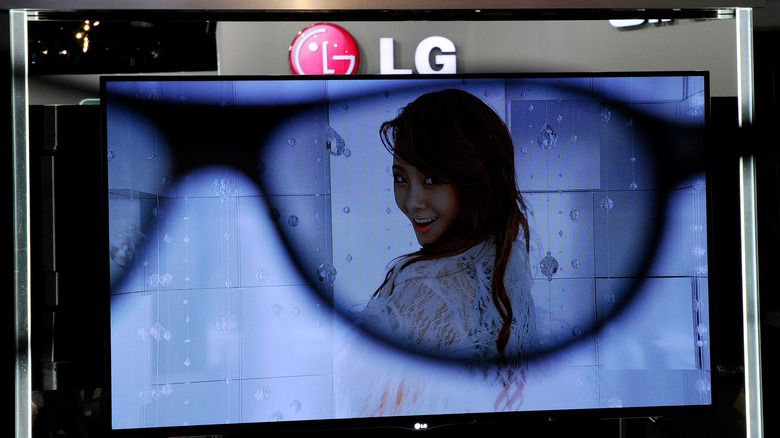Active Vs. Passive 3D TVs - What's The Difference?
The rise and fall of 3D TVs came and went relatively quickly. Despite a brief period of whirlwind success in the early-to-mid-2010s, the concept of 3D televisions has mostly been relegated to a mildly interesting novelty rather than the wave of the viewing future it was poised to be. That said, while they're not the dominating television format these days, there are still some 3D TVs floating around, either as holdovers from that high time or the occasional new creation. If you're interested in one, you could probably get it for dirt cheap.
Before you buy a 3D TV, though, there's something important you should know. First of all, there are actually two kinds of 3D TVs: Active 3D and Passive 3D. While both of these configurations provide the same general effect of adding pop-out depth to what you're watching, they achieve it in completely different ways. The kind of 3D effect a 3D TV uses can affect both your level of comfort while watching and the necessity of certain peripherals, so it's important you know the specifics of both types.
Active 3D flickers frames between both eyes and requires specialized glasses
If you're looking at a fancier, more expensive 3D TV (or at least one that was more expensive when these things were in vogue), there's a decent chance that it'll be packing Active 3D technology. This is because Active 3D is a much more intensive process, which requires a specialized set of 3D glasses.
Video displayed in Active 3D is constantly flickering between frames angled for your left and right eyes. On its own, this would just lead to a lot of crosstalk, the phenomenon wherein you see blurry images superimposed over one another. This is where the special glasses come in: Active 3D glasses are battery-powered devices that are directly synchronized to the TV itself. As the TV flickers frames back and forth, the 3D glasses use built-in shutters to cover the eye that's not being shown to in exact time with the video. This creates a situation where only your left eye sees the right-angled image, then your right eye sees the left-angled image, and so on. Do that fast enough, and you get the illusion of depth.
Passive 3D alternates horizontal lines only and uses simpler glasses
Compared to the more elaborate technologies of Active 3D, TVs that utilize Passive 3D are comparatively much simpler. There's less going on in the 3D process, and you can use a generic pair of 3D glasses, the same plastic ones you'd get at a movie theater.
Rather than flipping back and forth between angled frames, Passive 3D blends both angles into a single, overlapping frame. This would look blurry as-is, so the frame is interspersed with specially-polarized horizontal lines in alternating positions. The left and right lenses on a regular pair of 3D glasses both have different levels of polarization; the left eye can only see the half of the image whose lines match its polarization, while the right eye sees the other half of the image. When you look through both of these lenses at the same time, your brain fills in the blanks and merges them together into a single, multi-angled image. This is the same kind of 3D that's been used in theaters for decades, though we've long-since moved past the need for the solid red and blue lenses in 3D glasses.
Active 3D provides a larger picture, but Passive 3D is easier on the eyes
So, which kind of 3D is better for your viewing needs? It depends heavily on your standards for image quality, as well as your level of tolerance for flickering, flashing imagery. Due to the nature of its image blending, Passive 3D video automatically cuts the vertical resolution of the video in half. Active 3D, on the other hand, maintains its full resolution at all times, so the picture is larger and clearer.
However, that image quality comes with a big asterisk. As we mentioned before, the way Active 3D is rendered would produce a lot of crosstalk, blur, and visible flickering without the 3D glasses, especially if the screen has a low refresh rate. Even with the glasses, though, you'll almost definitely still catch a decent amount of that crosstalk, which can be uncomfortable for your eyes after prolonged viewing.
It's also worth noting that, since they're separate devices, Active 3D glasses can be expensive and hard to use, which is cited as one of the reasons this 3D TV model was a failure. On the other hand, you can use any old pair of 3D glasses you've got lying around for Passive 3D. If you care a lot about image resolution and are generally resilient against flickering, you might get more out of an Active 3D TV. Otherwise, you might want to spare your eyes the strain and settle for Passive 3D.


